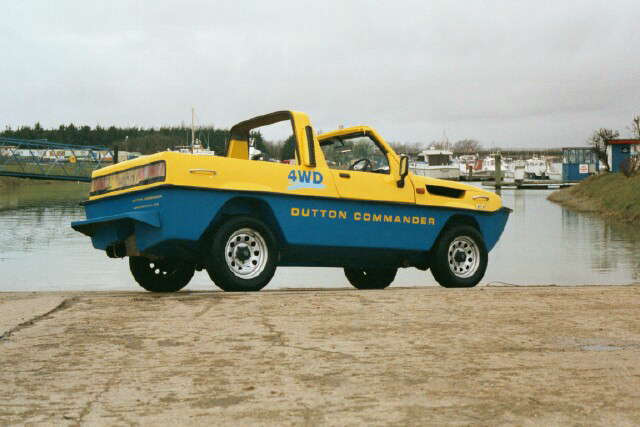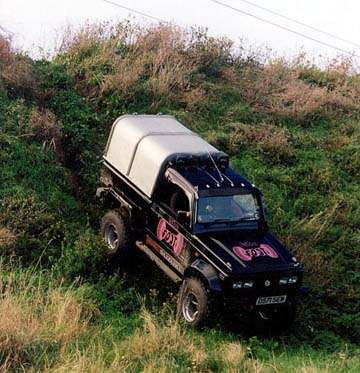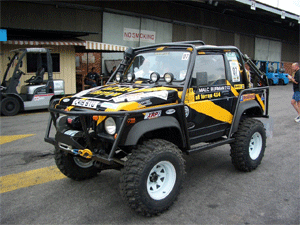There may be a number of reasons for wanting to have a dual batteries fitted to your vehicle. Installing a second battery is recommended for anyone who puts a much larger than usual load on the electrical system of thier vehicle, be it because of a winch, high wattage spotlights, a camping fridge, or any other electrical accressories.
Although installing a second 12 volt battery is fairly simple, there are a number of different ways that the back-up battery can be connected. It can be connected directly to the main battery, or it can be connected via an Isolator. If you decide to use an isolator, you will need to decide whether you prefer a simple electronic isolator, or a solenoid (relay) isolator.
With the dual batteries connected directly, both batteries will charge and discharge equally at the same time. With the Isolators, each battery charges and discharges independently. As with everything in life,each method has it's own pros and cons.
Mounting the Second battery
Irrespective of how you decide to connect the two batteries, it is recommended that the negative terminal of the second battery should be earthed to the chassis of the vehicle, and not to the negative terminal of the main battery. Always connect the two positive terminals together (wired in parallel). If the positive terminal of one battery is connected to the negitive terminal of the other (wired in series), you wil end up with 24 volts, not 12V.
In all instances, the additional battery still has to be mounted securely. An unsecured battery may tip over and spill acid, or worse, may short out against the vehicle frame or other metal object and cause a fire. An ideal position to mount this second battery is opposite to the original existing battery. Start by making the bracket that will hold the battery, and then secure this bracket to the engine bay of your Suzuki SJ.
Warnings and Safety
No matter what kind of battery you use, they can be dangerous if not treated with care.
When working with batteries, you need to have plenty of ventilation. Wear protective clothing, including safety glasses, and exercise caution.
It is possible for batteries to give off a flammable gas that can be potentially explosive. Avoid smoking, sparks, and open flames.
Batteries contain a sulfuric acid electrolyte which is a highly corrosive liquid. In case of a spill or splash, flush the affected area immediately with lots of cold water to dilute the acid. Seek medical assistance if in any doubt.
Treat batteries with the respect they deserve.
The output of the second battery should be fused, in the same way that the main battery output is fused. Ensure that the fuse is placed as close to the battery as possible. Always run the power to the accessories through a second fuse box.
Direct connection
This is the simplest way to connect a dual battery system, but probably the most ineffective way as well. Accessories connected to battery #2 will drain power from battery #1, your main battery, leaving you with two dead batteries when you least expect it. With the two batteries connected directly, the batteries will take on all the characteristics of the weakest battery.
Begin by running a Red 12 guage wire (or welding cable) from the positive terminal of the main battery along the rear firewall to the the positive terminal of the secondary battery. Make sure the ends are insulated, and do not connect anything just yet. Make sure that when you are ready to connect the batteries, that you connect positive to positive. Next run a length of Black 12 guage cable from the negative terminal of the second battery to a good earth point, and connect one end of this wire to the chassis and the other end to the negative terminal of the battery.

Carefully connect the first battery, making sure that the other end of the cable is still insulated. Once this is connected, move on to the other battery, and make the final connection that will link the two batteries together. All that is now left to do is to run a fused wire to the accessory.
Even with identical batteries, there can be slight differences in charge and resistance that could cause them to self-discharge when the alternator is not supplying power.
Electronic isolator connection
Very basically, an electronic isolator consists of two very high current diodes attached to a large heatsink capable of dissipating the heat produced by the diodes. This system provides a simple isolation between the two batteries but does require removing the alternator output cable from the battery and connecting it to the isolator.

With the electronic isolator system, both batteries receive current from the alternator and the voltage will equalise throughout the system while the alternator is in operation. One cable is then run from one of the isolator outputs to the positive terminal of the main battery, and a second cable from the remaining isolator output to the positive terminal of the auxiliary battery. If you choose this method, make sure that you use an electronic isolator capable of at least 150 Amps.
The electronic isolator has the advantage of long a life and trouble free operation, but many of the diode based isolators cause a small voltage loss (0.4 to 0.6 volts). This means that the batteries will not charge to as high a voltage as when they are connected directly to the alternator. The above diagram shows the connection for the diode based isolator.
Solenoid isolator connection
The purpose of the solenoid is to isolate the two batteries from each other irrespective of whether or not the engine is running. This is probably the best way to connect a dual battery system, but it is the most involved, and also the most expensive method.
Diagram of basic solenoid connection
Depending on how you want to activate and use the two batteries, there are different methods to connect them. If you want to use one battery at a time, both together, jump starting yourself with your second battery, or isolating both batteries, you will need to install a "Marine" switch (Option 2). If you are not really that concerned, and just want to protect and control the charging of the second battery, then Option 1 is probably the way to go.
Option 1
This is the easier of the two solenoid installations methods. It utilises a 300 Amp continuous duty solenoid (such as a 12V Cole & Hersee Constant Rated Solenoid, or a White -Rogers 70-111224-5) to control the flow of high current. The high current solenoid determines whether the second battery is connected to the charging circuit or not, and it is activated by a standard 30Amp automotive relay.
The standard 30Amp automotive relay is connected to the ignition via a normally open switch. The circuit diagram includes an optional "charge" notification circuit, although an illuminated light switch could be used.

Option 2
Once again, this isolator uses a 300Amp continuous duty solenoid to control the flow of current, and thus determine whether the second battery is connected or not.
In addition to the high voltage solenoid, you will need three standard SPDT 30A automotive relays, and a normally open switch (a Suzuki SJ demister switch). The solenoid will need to be switched with a high current "Marine" quality battery switch. The other relays allow the switching to take place.
Most marine switches are compact 4 position (one, two, both, none) 300A continuous rated switches. This allows the user to select either the main battery, the auxillary battery, or both. An advantage of the "Both" position is that you can jump start yourself if necessary. The "None" facility allows you to disable both batteries. Marine switches are supplied by companies like Blue Sea Systems, Perkiss, or Guest.
Solenoids don't prevent multi-battery drain, they only delay it. In fact, the current surge that occurs when the batteries are reconnected has been known to cause electrical damage. The main disadvantage is that the reliability isn't quite as good as the diode based isolator.





![0610_4wd_01z+suzuki_samurai+group_of_suzukis[1274].jpg](/images/gallery/favourites/0610_4wd_01z+suzuki_samurai+group_of_suzukis[1274].jpg)







![fenderfrt6_SJ-1[376].jpg](/images/gallery/favourites/fenderfrt6_SJ-1[376].jpg)







